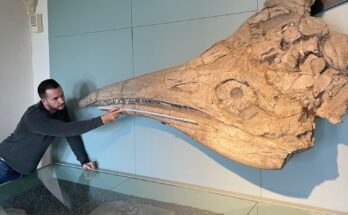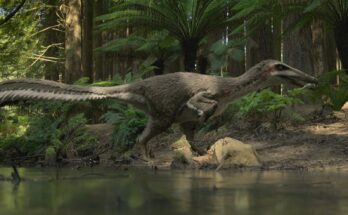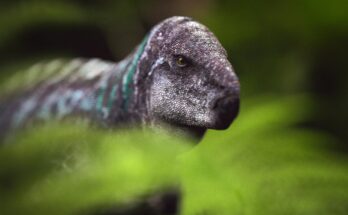Introduction
Tyrannosaurus rex—the very name strikes fear and fascination into our hearts. As the most famous dinosaur of all time, T. rex has dominated pop culture and scientific debates for over a century. But how much of what we “know” about this legendary predator is fact, and how much is myth?
In this complete guide, we’ll uncover:
✔ The bone wars & early discoveries that shaped our understanding
✔ Anatomy of a killer—size, strength, and senses
✔ Hunter or scavenger? The great T. rex debate
✔ Its brutal battles with Triceratops & other dinosaurs
✔ Why it went extinct—and its living relatives today
Get ready to meet the king of the dinosaurs!
Chapter 1: Discovery & Naming—A Fossil Feud
The First Fossils (1890s-1905)
- First teeth found (1874)—but misidentified as a “dinosaurian carnivore.”
- Barnum Brown’s legendary discovery (1902)—the first partial skeleton in Montana, later named Tyrannosaurus rex (“tyrant lizard king”) by Henry Fairfield Osborn (1905).
- “Sue” (1990)—the most complete T. rex ever found (90% intact), sold for $8.3 million!
The Bone Wars Backstory
- Rival paleontologists Cope & Marsh competed to find bigger dinosaurs—but missed T. rex!
- Later, Barnum Brown (American Museum of Natural History) became the “T. rex hunter.”
Fun Fact: Early reconstructions showed T. rex standing upright like a kangaroo—until 1970s science corrected it!

Chapter 2: Anatomy of a Killer
Size & Strength
- Length: Up to 40 feet (12 m)—longer than a school bus!
- Height: 12-20 feet (3.6-6 m) at the hips.
- Weight: 9-15 tons—as heavy as 2 African elephants!
- Bite Force: 8,000-12,000 psi (strongest of any land animal ever).
Deadly Weapons
✔ Serrated, banana-sized teeth (some over 12 inches long!)
✔ Powerful legs (could run 10-25 mph in short bursts)
✔ Tiny but muscular arms—still strong enough to lift 400 lbs each!
Super Senses
- Best vision of any dinosaur? Forward-facing eyes for 3D depth perception.
- Killer sense of smell—could detect rotting flesh from miles away.
- Advanced hearing—likely communicated with deep roars (below 20 Hz).
Myth Buster: T. rex could NOT see you if you stood still—that’s a Jurassic Park myth!

Chapter 3: Hunter or Scavenger? The Great Debate
Evidence for Hunting
✔ Bite marks on prey bones (Triceratops, Edmontosaurus)
✔ Strong legs for chasing (though not a marathon runner)
✔ Binocular vision (like modern predators)
Evidence for Scavenging
✔ Huge olfactory bulbs (great for sniffing carcasses)
✔ Massive size—may have scared off smaller predators
Verdict? Probably both—an opportunistic apex predator!

Chapter 4: Epic Dinosaur Battles
T. rex vs. Triceratops
- Fossil evidence shows violent clashes—broken horns, healed bite wounds.
- T. rex likely attacked the neck or flanks to avoid the deadly horns.
T. rex vs. Edmontosaurus
- Faster prey—but T. rex may have ambushed them near rivers.
Did T. rex Fight Each Other?
✔ Skull injuries suggest brutal face-biting contests over territory.

Chapter 5: Extinction & Legacy
The Asteroid That Killed the King
- 66 million years ago, the Chicxulub impact wiped out T. rex and all non-avian dinosaurs.
Living Relatives?
- Birds are the only surviving dinosaurs—chickens share a surprising amount of DNA with T. rex!
Pop Culture Icon
- “Jurassic Park” (1993)—made T. rex a superstar.
- Science Updates: Feathers? Possibly as juveniles!
Conclusion: Why T. rex Still Rules
More than just a “monster,” T. rex was a highly evolved predator that dominated its world. Even after extinction, it remains the undisputed king of dinosaurs.
Final Thought: If T. rex had survived… would humans have ever evolved?
Want More Dino Content?
✅ Follow for weekly prehistoric deep dives!
✅ Comment: Who would win—T. rex or Spinosaurus? 🦖🔥


